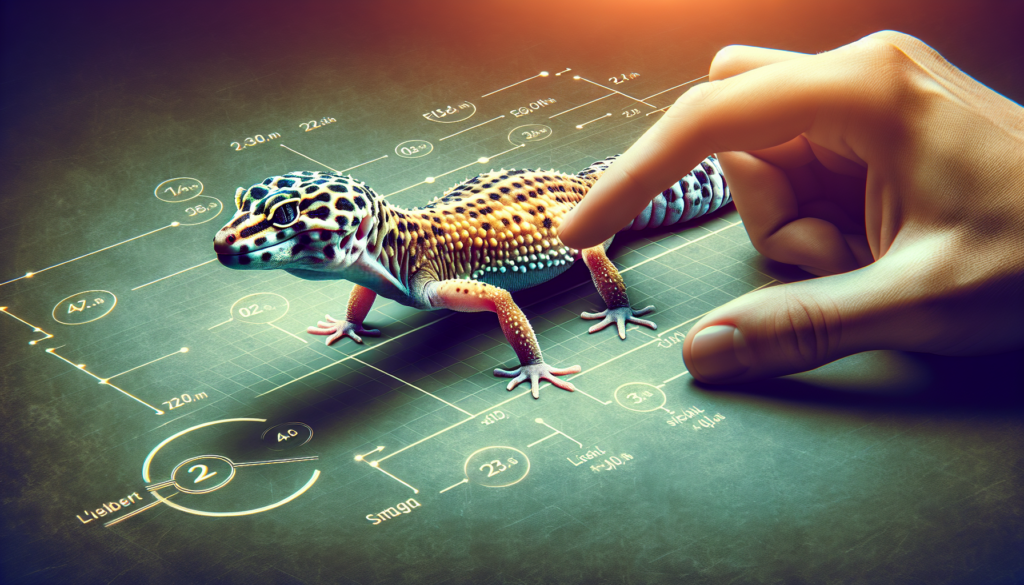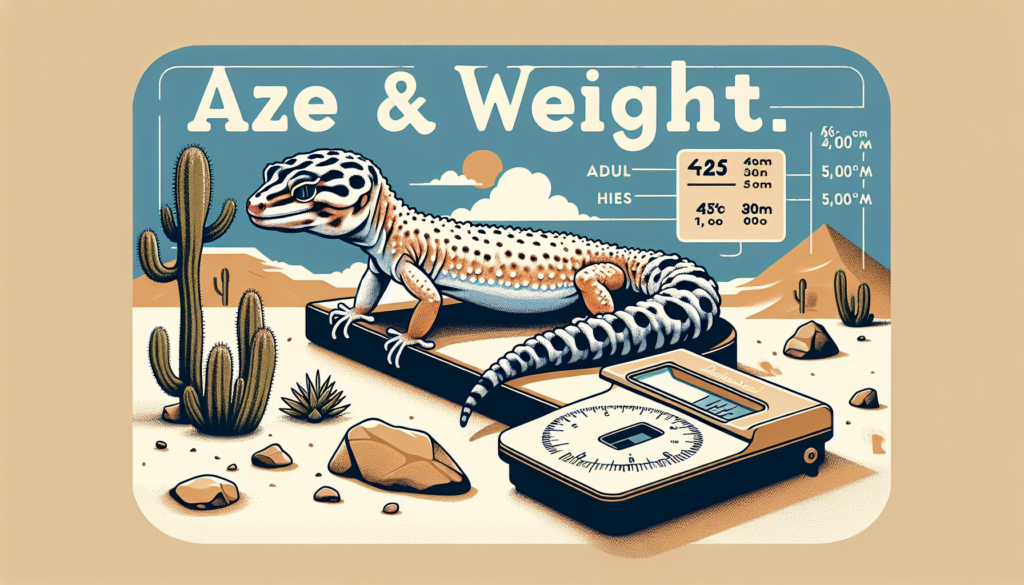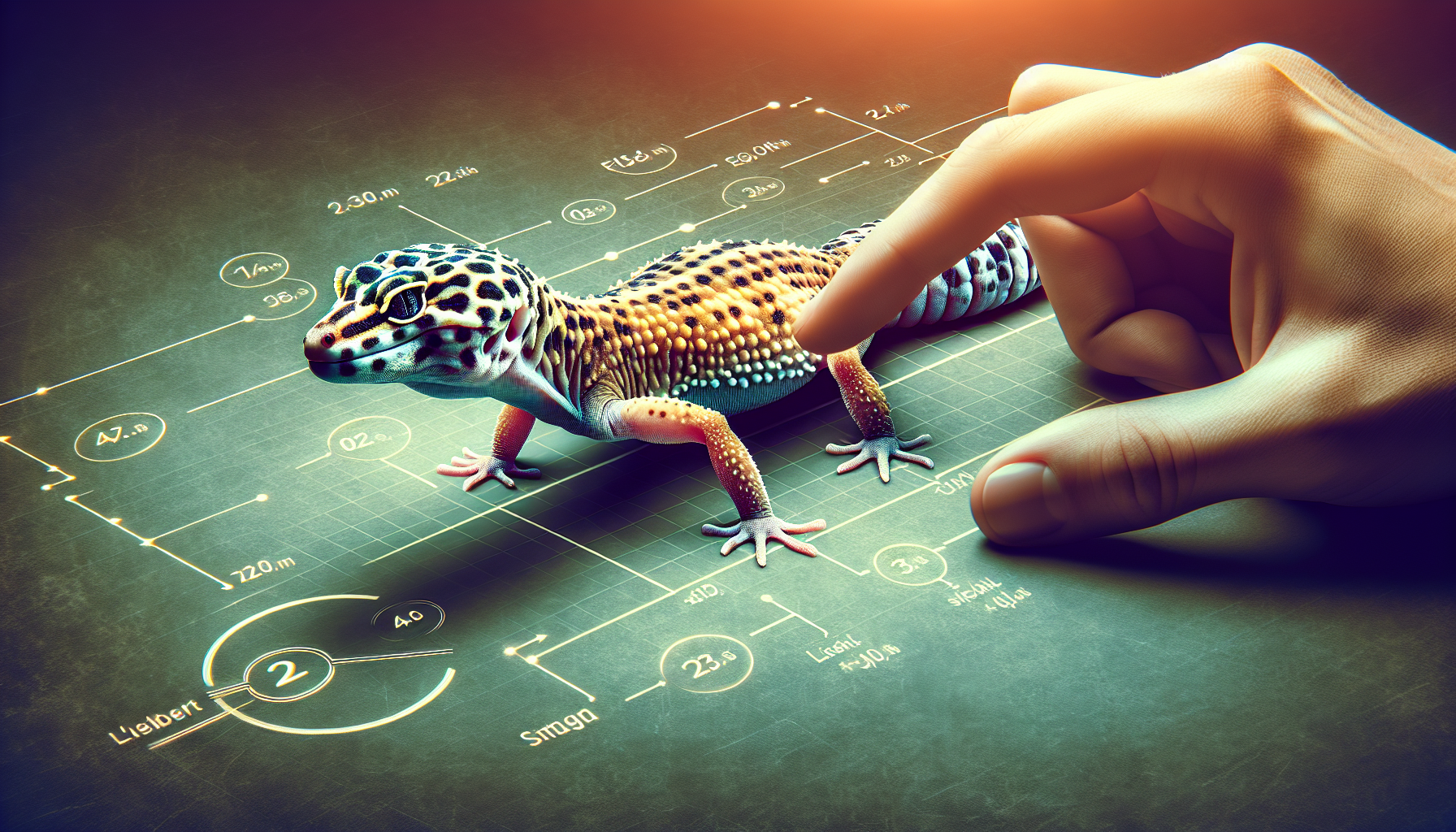Are you curious about the Leopard Gecko’s size and weight? If so, get ready to discover fascinating details about this unique reptile. From its petite stature to its surprisingly hefty physique, the Leopard Gecko’s dimensions are truly intriguing. Whether you’re a seasoned gecko enthusiast or just starting your journey into the world of reptiles, understanding the size and weight of these marvelous creatures will give you a deeper appreciation for their remarkable characteristics. So, let’s dive into the realm of Leopard Gecko size and weight and uncover the secrets behind their impressive physical traits.
Leopard Gecko Size
Average Size
Leopard geckos are a medium-sized species of gecko, with adult males averaging around 8 to 10 inches in length, and adult females typically measuring between 7 to 9 inches. These measurements are from snout to vent, not including the tail. The tail itself can range from 5 to 8 inches long, making up a significant portion of their overall size. It’s important to note that these measurements are just averages, and individual geckos can vary slightly in size.
Factors Affecting Size
Just like any living creature, there are several factors that can influence the size of a leopard gecko. Genetics play a major role, as certain genetic traits can result in larger or smaller individuals. Additionally, the overall health and nutrition of the gecko during its growth stages can affect its final size. Proper husbandry practices, including adequate temperature, lighting, and a balanced diet, are essential for promoting optimal growth and size.
Growth Rate
Leopard geckos, like most reptiles, grow at a slower rate compared to mammals. Hatchlings typically measure around 3 to 4 inches, and they experience a growth spurt during their first year of life. After that, their growth rate slows down significantly, with some individuals continuing to grow until they reach two years of age. It’s important to monitor their growth during this time to ensure they are reaching their full potential and to detect any potential health issues.
Comparison to Other Gecko Species
Leopard geckos are on the larger side when compared to other gecko species. While their average size falls within the range previously mentioned, other geckos can vary greatly in size. For example, the dwarf gecko species is much smaller, with adults typically reaching only 2 to 3 inches. On the other hand, some giant gecko species can grow up to 12 inches or more. So, when considering gecko size, it’s important to take into account the specific species in question.
Leopard Gecko Weight
Average Weight
The weight of a leopard gecko can vary greatly depending on its age, sex, and overall health. Adult male leopard geckos typically weigh between 60 to 80 grams, while adult females tend to be slightly smaller, weighing around 45 to 65 grams. Hatchlings weigh significantly less, usually ranging from 2 to 5 grams at birth. It is important to note that these are average weights, and individual geckos may fall outside of these ranges.
Factors Affecting Weight
Similar to size, several factors can influence the weight of a leopard gecko. Genetics play a role, as certain genetic traits can result in larger or smaller individuals. In terms of overall health and weight, a properly balanced diet is crucial. Providing the gecko with a diet that includes a variety of insects, supplemented with calcium and vitamins, will help promote healthy weight gain.
Healthy Weight Range for Different Ages
The weight of a leopard gecko can vary depending on its age. Hatchlings should steadily gain weight during their first few months, aiming to double their birth weight by four months of age. After this initial growth phase, the weight gain slows down, and leopard geckos should maintain a stable weight through adulthood. Regular weighing and monitoring of weight is recommended to ensure the gecko remains within a healthy range for its age.
Comparison to Other Gecko Species
Compared to other gecko species, leopard geckos are generally considered to be of medium weight. Some smaller species, such as the day gecko, can weigh as little as a few grams, while larger species, such as the tokay gecko, can reach weights of 100 grams or more. Understanding the typical weight range of the specific gecko species you are interested in is important for proper care and understanding of their needs.

Size and Weight Variation
Sexual Dimorphism
Sexual dimorphism is the term used to describe the physical differences between males and females of a species. In the case of leopard geckos, males are generally larger and heavier than females. This difference in size is most noticeable in adult geckos, with males often having a more robust appearance compared to their female counterparts. However, it’s important to note that these differences may vary from individual to individual and are not always strictly applicable.
Geographical Variations
Leopard geckos exhibit some variation in size and weight depending on their geographical location. Different populations in the wild may have slightly different average sizes and weights due to environmental factors and genetic variations. For example, geckos from a hotter region may have a smaller body size to help them regulate heat more efficiently, while geckos from a cooler area may grow larger to retain heat.
Individual Variation
Beyond sexual dimorphism and geographical differences, there is also variation among individuals within the same population. Just like humans, leopard geckos can have genetic variations that result in differences in their size and weight. Additionally, factors such as health, diet, and overall care can impact the growth and size of an individual gecko. It’s essential to consider these individual variations, monitor them closely, and make care adjustments as needed.
Measuring Leopard Gecko Size and Weight
Tools for Measurement
Measuring the size and weight of a leopard gecko requires some specific tools. For size measurement, a ruler or tape measure is commonly used, and it is essential to measure from the tip of the gecko’s snout to the vent. As for weight measurements, a digital scale capable of accurately reading in grams is needed. It is important to use equipment with precision and accuracy to obtain reliable measurements.
Procedures
To measure the size of a leopard gecko, it is important to handle them gently and securely. Place the gecko on a flat surface and gently straighten out its body. Use the measuring tool to measure from the tip of the snout to the vent, excluding the tail. For weight measurement, place the gecko on the scale and allow it to sit calmly. Make sure to subtract the weight of any container or substrate used, and record the gecko’s weight.
Recommended Frequency of Measurement
While it is important to monitor the size and weight of a leopard gecko, it should be done in a way that minimizes stress and disturbance to the gecko. For most owners, measuring size and weight once a month is sufficient for monitoring growth trends. However, if there are any concerns about the gecko’s health or growth rate, more frequent measurements may be necessary. It is crucial to handle the gecko with care and ensure it is comfortable during the measuring process.

Leopard Gecko Growth
Growth Stages
Leopard geckos go through various growth stages as they develop from hatchlings to adults. The first stage is the hatchling phase when they emerge from their eggs. During this time, they rapidly grow in size and weight. The second stage is the juvenile phase, which typically lasts about a year. During this stage, their growth rate slows down, and they start to develop their adult coloration. Finally, they transition into the adult phase, where their growth rate slows down further, and they reach their full size.
Signs of Healthy Growth
Healthy growth in leopard geckos is characterized by steady and consistent growth patterns. Hatchlings should steadily gain weight and length in their first few months. As they transition into the juvenile phase, their growth rate will slow down, but they should continue to gain weight and length, albeit at a slower pace. Signs of healthy growth include a sturdy body with good muscle tone, clear eyes, and a healthy appetite.
Uncommon Growth Patterns
While healthy growth patterns are the norm, there can be rare instances where geckos may experience abnormal growth. Some individuals may experience stunted growth, where their growth rate is significantly slower than average. On the other hand, there may be cases of accelerated growth, where a gecko appears to be growing at a faster rate than usual. These unusual growth patterns can be an indication of underlying health issues, and prompt veterinary attention is recommended.
Diet and Nutrition Impact on Size and Weight
Relationship between Diet and Size/Weight
diet and nutrition have a direct impact on the size and weight of a leopard gecko. Providing a balanced and varied diet is crucial for promoting optimal growth. In the wild, leopard geckos primarily feed on insects, with their diet consisting of crickets, mealworms, and waxworms, among others. A diet lacking in variety or missing essential nutrients can result in stunted growth and poor overall development.
Dietary Requirements for Growth
To support healthy growth, a leopard gecko’s diet should be rich in high-quality insects. gut-loading the insects with nutritious food and dusting them with calcium and vitamin supplements helps ensure the gecko receives the necessary nutrients for growth. Mealworms and crickets are commonly fed to leopard geckos, while waxworms and superworms can be offered as occasional treats due to their higher fat content.
Obesity and Underweight Issues
Both obesity and underweight issues can affect the health, size, and weight of a leopard gecko. Overfeeding or feeding an imbalanced diet can lead to obesity, which puts strain on the gecko’s organs and joints. On the other hand, underfeeding or inadequate nutrition can result in weight loss, lack of growth, and weakened immune function. Maintaining a proper feeding schedule, monitoring portion sizes, and providing a well-rounded diet are essential for preventing these issues.
Health Factors that Affect Size and Weight
Parasites and Diseases
Parasites and diseases can have a significant impact on the overall health and growth of a leopard gecko. Internal and external parasites, such as mites and worms, can cause weight loss, digestive issues, and general weakness. Infectious diseases, respiratory infections, and metabolic disorders can also affect the gecko’s appetite, leading to weight loss and stunted growth. Regular health checks by a qualified reptile veterinarian and proper hygiene practices can help prevent and detect these issues.
Respiratory Issues
Respiratory issues, such as infections or lung diseases, can affect a leopard gecko’s breathing and overall health. These conditions can reduce their appetite and lead to weight loss. Poor cage ventilation, high humidity levels, and low-quality substrate can contribute to respiratory issues. maintaining appropriate temperature and humidity levels within the gecko’s enclosure, along with regular cleaning, can help minimize the risk of respiratory problems.
Other Health Concerns
Leopard geckos can also be susceptible to other health concerns, such as metabolic bone disease, mouth rot, and impaction. These conditions can impact the gecko’s growth, size, and weight. Metabolic bone disease, caused by calcium and vitamin D deficiency, can result in skeletal deformities and stunted growth. Mouth rot and impaction, which can be caused by improper feeding or inadequate husbandry, can lead to weight loss and other health complications. Regular veterinary check-ups and proper care practices are crucial for preventing and addressing these issues.
Factors Influencing Body Condition
Temperature and Humidity
Temperature and humidity levels within a leopard gecko’s enclosure play a crucial role in maintaining a healthy body condition. Leopard geckos require a warm and dry environment to thrive. Inadequate temperature or humidity regulation can impact their metabolism, digestion, and overall health. Low temperatures can slow down their metabolism, leading to weight loss, while high humidity levels can increase the risk of respiratory infections. Proper heating and humidity control systems are essential for maintaining optimal body condition.
Enclosure Size and Enrichment
The size of the gecko’s enclosure and the presence of enrichment items also influence their overall body condition. A spacious enclosure allows for natural movement, exploration, and exercise, which helps maintain muscle tone and proper weight. Enrichment items, such as climbing structures and hiding spots, encourage natural behaviors and mental stimulation, promoting a healthy body condition. Providing an appropriately sized enclosure and enriching it with various items is vital for the overall well-being of a leopard gecko.
Handling and Stress Levels
Stress can have detrimental effects on a leopard gecko’s health and well-being. Frequent handling, improper handling techniques, and exposure to loud noises or sudden changes can induce stress responses. During times of stress, geckos may refuse food, lose weight, or exhibit other signs of distress. Minimizing stress by providing a calm and consistent environment, practicing gentle handling, and avoiding unnecessary disturbances is important for maintaining their size and weight.
Breeding and Reproduction Impacts on Size and Weight
Female Size and Reproduction
Female leopard geckos need to reach a certain size and weight before they are ready to reproduce. Breeding too early can have negative effects on the health of the female and her potential offspring. Generally, a female leopard gecko should be at least one year old and weigh around 45 grams before being considered for breeding. This ensures they have reached a suitable size to carry and lay eggs without excessive strain on their body.
Effects of Breeding on Female Health
Breeding and egg production can have a significant impact on the size and weight of female leopard geckos. The process of producing, carrying, and laying eggs consumes a substantial amount of energy and resources from the female’s body. Without proper care, this can lead to weight loss and nutrient deficiencies. Providing a well-balanced diet, calcium supplementation, and proper nesting materials are essential for supporting the female’s health during the breeding process.
Male Size and Reproduction
While male leopard geckos do not carry and lay eggs like females, their size does play a role in successful reproduction. Larger and healthier males tend to have higher fertility rates and produce more vigorous offspring. Proper nutrition, temperature, and overall care are important for maintaining the male’s size and weight, thus ensuring their reproductive success.
Effects of Breeding on Male Health
Breeding can be a physically demanding process for male geckos as well. The mating behaviors and aggressive encounters with other males during breeding season can result in stress and potential injuries. Additionally, the energy exerted during courtship and mating can lead to weight loss and decreased overall health. Providing proper care, including a balanced diet and a stress-free environment, is essential for supporting the male’s health during the breeding process.
Size and Weight Consideration for Enclosure Setup
Appropriately Sized Enclosures
When setting up an enclosure for a leopard gecko, it is important to consider their size and potential growth. Hatchlings can start off in smaller enclosures but should be moved to larger enclosures as they grow. A 20-gallon tank is often suitable for adult leopard geckos, providing ample space for movement and enrichment. However, larger enclosures may be needed for particularly large individuals or if multiple geckos are housed together.
Choosing the Right Substrate
The choice of substrate in the leopard gecko’s enclosure can impact their body condition. Loose substrates, such as sand or gravel, can increase the risk of impaction if ingested during feeding or accidental ingestion while hunting. Solid substrates, such as reptile carpet or non-adhesive shelf liner, are safer options that minimize the risk of impaction. Carpet or towels placed under the heating elements can provide additional support and prevent burns.
Avoiding Overcrowding
Overcrowding can negatively impact the growth, health, and overall well-being of leopard geckos. Housing multiple geckos together in an enclosure that is too small can lead to increased stress, competition for resources, and the spread of diseases. It is essential to provide enough space for each gecko to establish their territories and exhibit natural behaviors without excessive interference or overcrowding. Proper monitoring and separation may be necessary if any signs of aggression or stress are observed.
In conclusion, the size and weight of a leopard gecko are influenced by various factors, including genetics, diet, health, and environmental conditions. Monitoring their growth, providing a balanced diet, and maintaining appropriate husbandry practices are key to ensuring their optimal size and weight. Remember to consult with a reptile veterinarian for specific advice and guidance tailored to your individual gecko’s needs. By prioritizing their well-being, you can ensure your leopard gecko thrives and lives a healthy, happy life.
